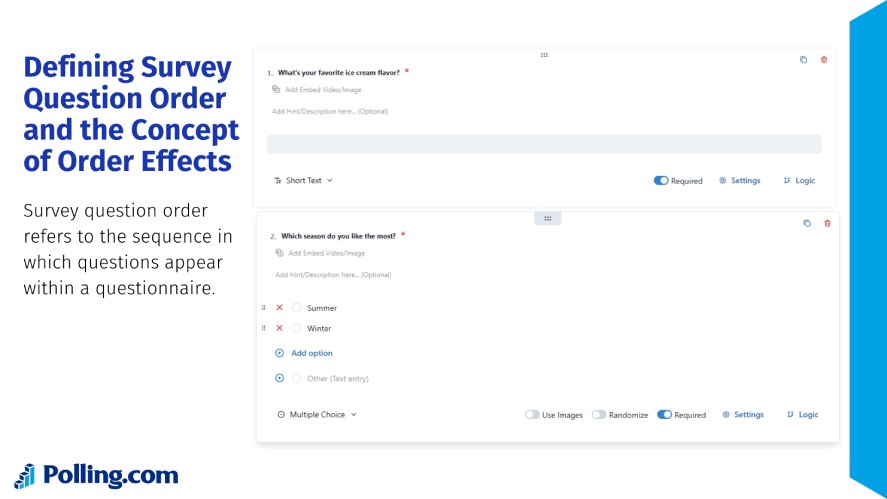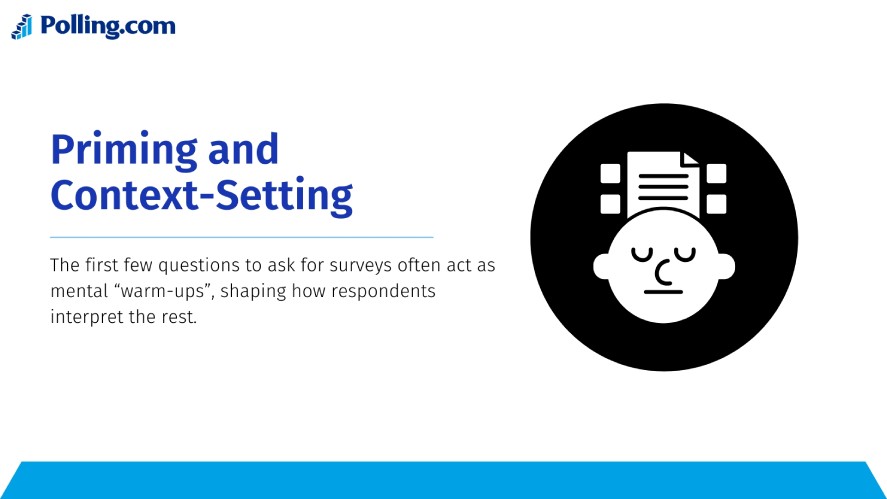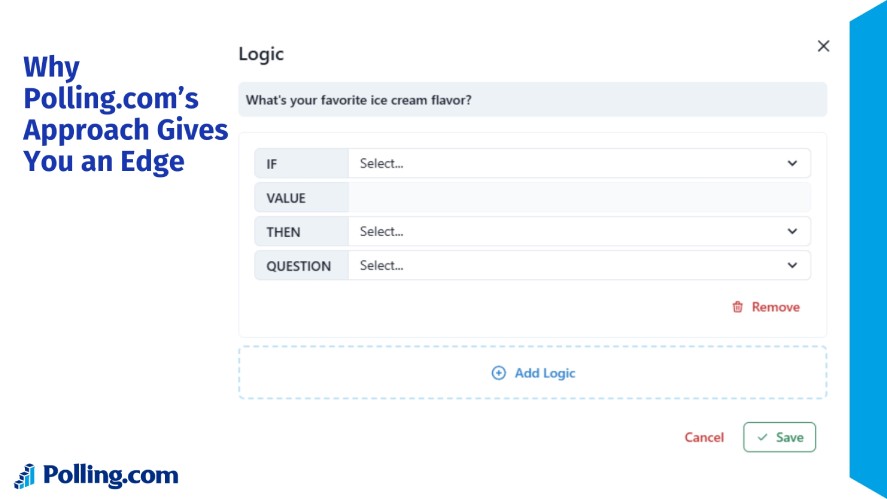
Survey Question Order: Why Sequence Affects Results
When designing a survey, most people focus on writing good survey questions, but few realize that the order of those questions can be just as important.
The way questions are arranged can subtly shape how respondents think, feel, and answer. It shows how does question order affect survey responses in subtle but measurable ways.
Known as survey question order effects, this phenomenon can significantly alter your data’s accuracy and reliability.
Whether you’re running a product feedback form, employee engagement survey, or market demand study, question order can influence outcomes through context, priming, and fatigue.
Understanding how to design a logical and unbiased survey flow ensures that your results truly reflect your audience, not just the way you asked them.
What is Survey Question Order and Why It Matters
In this section, let’s explore what survey question order really means, and why it plays such a crucial role in shaping your survey results.
Defining Survey Question Order and the Concept of Order Effects
Survey question order refers to the sequence in which questions appear within a questionnaire.
It’s a fundamental part of survey flow and structure: how to structure a survey questionnaire and how respondents progress from one topic to the next.

The order in which questions are asked can change the way people interpret and respond to them, a psychological phenomenon known as order effects.
For instance, if you first ask someone how satisfied they are with their life and then how satisfied they are with their job, their response to the second question may be influenced by their thoughts about their overall happiness.
This is called priming. It happens when an earlier question activates certain ideas or emotions that carry over into later ones.
In simple terms: question order doesn’t just organize your survey; it shapes the mindset in which participants answer.
How Sequence Has Been Shown to Affect Responses
Research in psychology and survey methodology consistently shows that question order can create meaningful differences in results.
For example:
- Schuman & Presser (1981) found that responses to attitude questions often changed depending on whether general or specific items came first.
- Tourangeau & Rasinski (1988) demonstrated the effects of priming in surveys, showing that earlier questions can prime respondents to think in a particular direction, leading to higher agreement with related statements later on.
- Studies on recency and primacy effects in surveys show that respondents tend to favor the first or last options presented, especially when questions are complex or when they’re fatigued.
Even small changes, like moving a pricing question before a satisfaction question, can shift how respondents evaluate a product or service.
These findings underline the importance of a deliberate and tested strategy to manage order effects in survey design.
The Impact on Data Quality, Validity, and Interpretation
When question order is poorly planned, your survey results can become biased without you realizing it.
For businesses and researchers, this means flawed insights and potentially costly decisions.
Here’s why it matters:
- Data Validity: If responses are influenced by question order instead of actual opinion, the data no longer reflects true customer sentiment.
- Decision-making: Misleading data can distort your understanding of product performance, customer loyalty, or market trends.
- Brand Credibility: Releasing or acting on biased survey results can damage your reputation or lead to misguided strategies.
In short, thoughtful survey question sequencing isn’t just an academic concern; it’s essential for collecting trustworthy data that drives real business value.
By mastering the principles behind question order in surveys and applying strategies to reduce survey bias, you ensure your surveys deliver insights you can confidently act on.
Common Mechanisms Behind Order Effects
Now that we understand what survey question order is, let’s look at why it affects responses.
Priming and Context-Setting
The first few questions to ask for surveys often act as mental “warm-ups”, shaping how respondents interpret the rest.
This is known as priming. It’s when earlier questions make certain concepts, emotions, or memories more top-of-mind.

For instance, if a survey begins with questions about environmental issues, respondents may later rate a brand that uses sustainable materials more favorably than they would have otherwise.
The initial context subtly frames their mindset, creating a ripple effect throughout the survey.
Assimilation and Contrast in Surveys
Assimilation effects occur when an earlier question pulls later responses in the same direction.
For example, if a respondent first agrees that their city has good public services, they may rate local government performance higher afterward.
Contrast effects, on the other hand, push responses in the opposite direction.
If the first question highlights something negative, like dissatisfaction with public transportation, the next question about overall city satisfaction might receive a lower score than it otherwise would.
Both mechanisms show how previous questions can shape, or even distort, perceptions that follow.
Fatigue, Boredom & Position Effects
Not all order effects are psychological, as some are simply practical.
As respondents progress through a long survey, survey fatigue can set in. They may start skipping questions, providing shorter answers, or losing focus.

This creates position effects, where earlier questions tend to get more thoughtful, accurate responses than those appearing near the end.
That’s why it’s important to place crucial questions toward the beginning and keep overall length reasonable to prevent drop-off and disengagement.
Visual Layout and Survey Mode Interactions
Even the way a survey is displayed can influence order effects.
For example, one study found that when multiple items were presented in a grid format, the order effect weakened compared to an item-by-item layout.
That’s because respondents could see all related types of survey questions at once, which reduced sequential priming.
Similarly, question order may behave differently across survey modes, like web, mobile, or phone, due to layout constraints and scrolling behavior.
This highlights the need to test your survey flow design across devices to ensure consistency and reliability.
Real‑World Examples of Survey Question Order Impact
Here are a few real-world examples showing how something as simple as question sequence can dramatically change survey outcomes.
Political or Public-Opinion Surveys
In political polling, the order of questions can influence how people rate leaders or policies.
For instance, when respondents are first asked about “the most important national problem”, their answers often focus on issues like inflation, healthcare, or security.
If the next question asks them to rate how well the current government or leader is handling their job, their response tends to reflect the issue they just mentioned; either boosting or lowering approval ratings.
This context-priming effect shows how early questions can frame later evaluations, leading to different interpretations of the same performance data depending on order.
Health and Medical Outcome Surveys
In healthcare studies, question order can change what respondents view as “essential”.
For example, if a medical survey begins by asking about personal health challenges, participants might later rank treatment options like pain relief or accessibility as more important.
But if the survey starts with questions about healthcare policies or general well-being, the same participants might instead prioritize affordability or prevention.
This demonstrates how context and framing shape what people focus on. It’s a crucial factor when decisions about funding or treatment programs rely on survey results.
Online Customer Feedback Surveys
Consider a company collecting feedback after a product purchase.
If the survey starts with questions about product quality (“How satisfied are you with the performance of the product?”), respondents may enter a critical or positive mindset that influences later loyalty questions (“How likely are you to recommend this brand?”).
But if they first recall product flaws, their loyalty score may drop. And if they recall positive aspects, it may rise.
Reversing the question order, like asking about overall satisfaction before diving into details, can produce notably different loyalty metrics.
This kind of assimilation and contrast effect shows why smart survey design is vital for accurate survey analysis.
An optimal survey question sequence prevents skewed perceptions and ensures the data truly represents how customers feel, not how they were primed to think.
Polling.com: Survey Design Best Practices for Question Order
Designing an effective survey isn’t just about writing clear questions; it’s also about knowing how to avoid bias in survey questions and asking them in the right order.
On Polling.com, where precision and insight drive every data point, thoughtful sequencing helps ensure your results are reliable, unbiased, and truly representative of respondent opinions.
Here’s how to approach question order strategically.
1. Start with Broad, Less Sensitive Questions and Move to Specific or Sensitive Ones
Begin your survey with general, easy-to-answer questions that help respondents ease into the process.

For example, overall opinions before diving into specific experiences or personal topics.
This structure prevents early survey questions from priming participants to focus on narrow issues too soon and reduces drop-off caused by discomfort or fatigue.
2. Group Logically Related Content, But Avoid Unintentionally Leading Sequences
Logical grouping (e.g., all product-related questions together) helps respondents maintain context.
However, watch for unintended leading effects, like where one question subtly shapes how the next is interpreted.
When possible, randomize question order within thematic sections to maintain balance between coherence and neutrality.
3. Consider Randomization or Rotation of Question Blocks
If questions or sections are not dependent on each other, Polling.com allows for block randomization or rotation.
This technique helps minimize systematic order bias. It ensurs that no single question consistently benefits (or suffers) from being shown first or last.
4. Use Pre-Testing and Split-Sample Experiments to Detect Order Effects
Before launching a large-scale survey, run A/B tests with different question sequences.
By comparing response patterns across versions, you can identify and correct for significant order effects.
Polling.com’s analytics tools make this process straightforward, allowing you to spot differences in tone, intensity, or consistency of answers.
5. Be Mindful of Layout, Device, and Survey Mode Influences
Question order interacts with survey presentation.

On web or mobile, a grid layout (where multiple items appear together) can lessen order survey response bias compared to a one-question-per-page format.
So, consider how respondents scroll, tap, or view content, as subtle UI design choices can amplify or mute order effects.
6. Document and Report Any Order-Based Differences
If your findings will inform decisions or be shared publicly, always disclose how question order may have influenced results.
Transparent reporting builds trust and shows that your data has been interpreted responsibly. It’s a best practice that reinforces credibility, especially in business and policy contexts.
Mitigating Risks and Validating Results
Even the best-designed surveys can be influenced by subtle cognitive bias in survey responses, but with the right safeguards, you can keep your data clean, consistent, and credible.
Polling.com provides built-in tools to help you detect, minimize, and correct these risks before insights are compromised.
Use Randomization Where Feasible
When questions or sections aren’t dependent on each other, apply randomization to vary the order across respondents.
This helps neutralize systematic bias and ensures that your findings reflect genuine attitudes rather than sequence-driven responses.
Keep Survey Length Reasonable to Reduce Fatigue & Drop-Off
Long surveys increase the risk of respondent fatigue, where attention and thoughtfulness decline over time.
So, keep your questionnaires concise and focused on essential items.
A good rule of thumb when deciding how long should a survey be is ideally under 10 minutes to maintain high-quality, engaged answers throughout.
Monitor for Response Patterns (Straight-Lining, Skipped Questions)
Use Polling.com’s analytics to flag low-quality responses such as straight-lining (selecting the same option repeatedly) or frequent skips.
These patterns often indicate boredom or confusion, both of which can distort results and mask order-related issues.
Analyse Data for Possible Order Effects (Compare Sub-Samples)
If you used split samples or randomized blocks, compare results across versions to detect order effects.
Look for shifts in mean ratings, response distributions, or sentiment polarity. These small changes can reveal meaningful bias introduced by sequencing.
Report Limitations and Consider Weighting or Trimming if Order Bias Detected
When presenting results, acknowledge any limitations due to randomized question order.
If certain items are clearly affected, apply weighting adjustments or trim biased data to maintain validity.
Transparent reporting not only upholds research integrity but also strengthens confidence in your conclusions.
Why Polling.com’s Approach Gives You an Edge
Managing question order is crucial for collecting accurate survey data, and Polling.com makes it easy to design surveys that minimize response bias in surveys and maximize insight.

Key features that give you an edge include:
- Built-in question-order logic and randomization to reduce sequence bias automatically.
- Pre-test split-sample segmentation to detect and compare order effects before full launch.
- Optimized layout for web and mobile to ensure consistent responses across devices.
- Advanced analytics and diagnostics to identify if early questions are influencing later responses.
With these tools, Polling.com helps ensure your survey results are reliable, actionable, and reflective of real opinions.
By addressing question-order effects from design to analysis, clients can make confident, data-driven decisions every time.
Key Takeaways & Action Steps
Survey question order can significantly influence responses, introducing bias that distorts data if not managed carefully.
To ensure accurate, actionable insights, follow these practical steps:
- Start with broad, neutral questions and progress to specific or sensitive items.
- Group related questions logically, but randomize within groups when possible.
- Use question-block rotation or randomization for non-dependent items.
- Pre-test with split-sample experiments to detect order effects.
- Keep surveys concise to reduce fatigue and drop-off.
- Monitor response patterns for straight-lining, skipped questions, or anomalies.
- Analyze sub-samples to spot potential order bias and report limitations if detected.
Review your current or upcoming surveys for question-order issues, because small adjustments can dramatically improve the quality and reliability of your data.
When in doubt, Polling.com offers tools and expertise to help optimize survey sequencing and flow.
Conclusion
Survey question order matters. From survey priming and anchoring, assimilation and fatigue, to questionnaire layout effects, sequence can subtly shape how respondents answer, impacting data validity and decision-making.
By designing surveys thoughtfully, testing sequences, and leveraging tools like Polling.com, you can mitigate bias and capture true insights.
Apply these tips to your next survey: structure your questions carefully, pre-test sequences, consult Polling.com for advanced survey design, and follow the best way to order survey questions.
Doing so ensures your data is reliable, actionable, and ready to drive confident, data-driven decisions.
